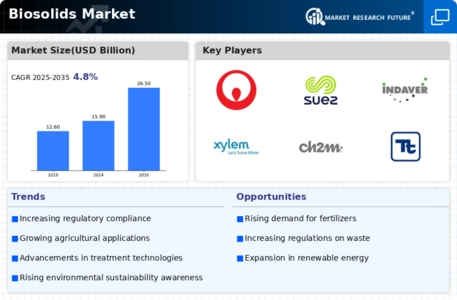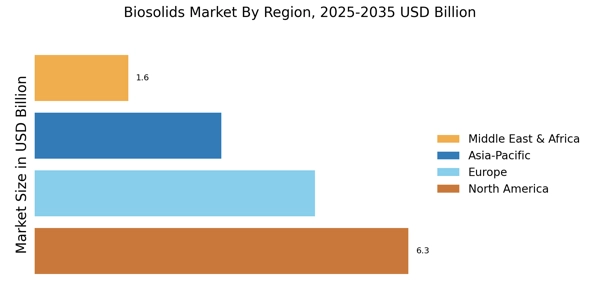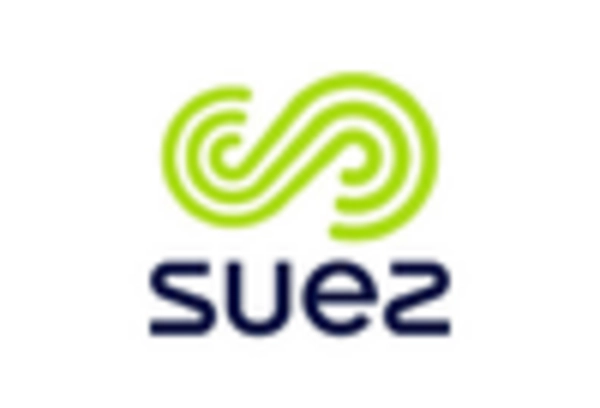Increasing Demand for Organic Fertilizers
The rising demand for organic fertilizers is a pivotal driver in the Biosolids Market. As consumers become more environmentally conscious, the preference for organic products over synthetic alternatives has surged. This trend is reflected in the agricultural sector, where farmers are increasingly adopting biosolids as a sustainable source of nutrients. According to recent data, the organic fertilizer market is projected to grow at a compound annual growth rate of over 10% in the coming years. This growth is likely to bolster the biosolids market, as these materials are rich in essential nutrients and improve soil health. The integration of biosolids into organic farming practices not only enhances crop yields but also promotes sustainable land management, thereby reinforcing the importance of the Biosolids Market.
Rising Population and Food Security Concerns
The escalating The Biosolids Industry. As the world population is projected to reach nearly 9 billion by 2050, the demand for food production is expected to increase dramatically. This necessitates the adoption of sustainable agricultural practices, including the use of biosolids to enhance soil fertility and crop yields. The Food and Agriculture Organization has indicated that sustainable practices, such as the application of biosolids, can play a crucial role in meeting future food demands. Consequently, the biosolids market is likely to experience growth as farmers seek effective solutions to improve productivity while maintaining environmental integrity. The intersection of population growth and food security challenges underscores the critical role of the Biosolids Market in addressing these pressing issues.
Advancements in Wastewater Treatment Technologies
Technological innovations in wastewater treatment are significantly influencing the Biosolids Market. Enhanced treatment processes, such as anaerobic digestion and thermal hydrolysis, are improving the efficiency of biosolid production. These advancements not only increase the quality of the end product but also reduce the volume of waste generated. For instance, anaerobic digestion can convert organic matter into biogas, which can be utilized as a renewable energy source. The global market for wastewater treatment technologies is expected to reach USD 500 billion by 2026, indicating a robust growth trajectory. This growth is likely to drive the demand for biosolids, as municipalities and industries seek to optimize their waste management practices while adhering to environmental regulations. Thus, the evolution of treatment technologies is a crucial factor in the expansion of the Biosolids Market.
Growing Awareness of Environmental Sustainability
The increasing awareness of environmental sustainability is driving the Biosolids Market forward. As societies grapple with the challenges of waste management and resource conservation, biosolids are emerging as a viable solution. Their application in agriculture not only recycles nutrients but also reduces the reliance on chemical fertilizers, thereby minimizing environmental impact. Recent studies indicate that the use of biosolids can lead to a 30% reduction in greenhouse gas emissions compared to conventional fertilizers. This growing recognition of the environmental benefits associated with biosolid use is likely to enhance market demand. Furthermore, educational initiatives aimed at promoting the advantages of biosolids in sustainable practices are expected to foster greater acceptance among farmers and policymakers alike, thereby propelling the Biosolids Market.
Regulatory Framework Supporting Biosolid Utilization
The establishment of regulatory frameworks that support the beneficial reuse of biosolids is a key driver in the Biosolids Market. Governments are increasingly recognizing the environmental and economic benefits of recycling biosolids in agriculture and land reclamation. Regulations that promote the safe application of biosolids in farming not only enhance soil fertility but also reduce landfill waste. For example, the U.S. Environmental Protection Agency has set guidelines that facilitate the safe use of biosolids, which has led to a rise in their application in various sectors. As more countries adopt similar regulations, the market for biosolids is expected to expand. The potential for biosolids to contribute to sustainable development goals further underscores their importance in the Biosolids Market.


















Leave a Comment